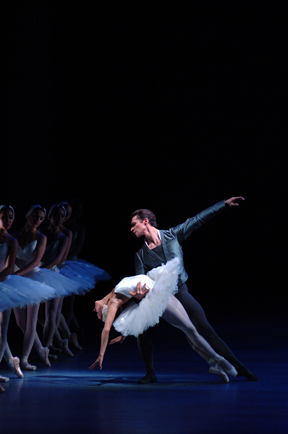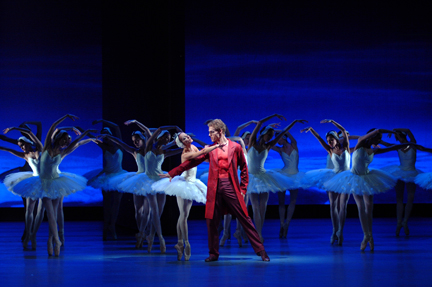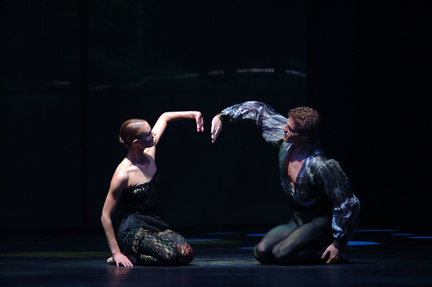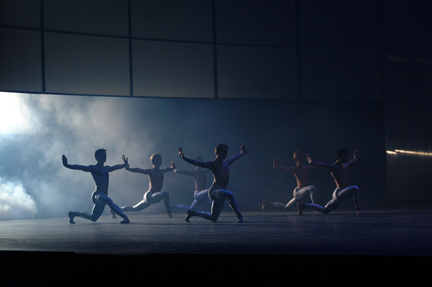“Swan Lake"
Zuercher Ballett
December 19, 2006
A Midsummer Night's Dream
December 20, 2006
Opernhaus Zuerich
Zurich, Switzerland
by Rita Felciano
copyright 2006 by Rita Felciano
 The Zuercher Ballet's recent productions of "Swan Lake" and "A Midsummer Night's Dream" went some way to explain why this company has become, maybe not a major, but at least respectable player in European ballet. Artistic director and choreographer Heinz Spoerli is an unabashed neo-classicist, embracing the basic tenets of the academic vocabulary and making extensive use of point work. While this might him label as a conservative in some circles, his concept-driven ballets are anything but old-fashioned. Spoerli also is an astute and sensitive musician, choreographing such 20th century composers as Gyorgi Ligeti, Lucano Berio and Alfred Schnittke as well as more familiar scores by Bach, Mozart and Brahms. At the very least, his choreographies, as is the case with "Swan Lake" and "Midsummer Night's Dream," ask challenging questions about translating ideas into contemporary expressions by way of classical ballet.
The Zuercher Ballet's recent productions of "Swan Lake" and "A Midsummer Night's Dream" went some way to explain why this company has become, maybe not a major, but at least respectable player in European ballet. Artistic director and choreographer Heinz Spoerli is an unabashed neo-classicist, embracing the basic tenets of the academic vocabulary and making extensive use of point work. While this might him label as a conservative in some circles, his concept-driven ballets are anything but old-fashioned. Spoerli also is an astute and sensitive musician, choreographing such 20th century composers as Gyorgi Ligeti, Lucano Berio and Alfred Schnittke as well as more familiar scores by Bach, Mozart and Brahms. At the very least, his choreographies, as is the case with "Swan Lake" and "Midsummer Night's Dream," ask challenging questions about translating ideas into contemporary expressions by way of classical ballet.
Spoerli's 2005 "Swan Lake," the third one in his career, is both traditional and radical. He stripped the work of its narrative content-claiming that everyone knows the story-and re-focused the ballet squarely around Siegfried, danced by a handsome technically solid Estonian Stanislav Jermakov. There is no story, only an atmosphere of oppressive rigidity from which Siegfried vainly tries to escape.
Florence von Gerkan put the men in cadet uniforms and the women in tightly tailored jackets, with simple, beige-tone skirts underneath. The ballroom, with straight-backed chairs and everyone sitting ramrod straight, resembled a military's school's assembly hall.
The most intriguing change was Spoerli's conflating the figure of the Tutor and von Rothbart into a single sinister force of domination and subjugation. Dirk Segers moved easily back and forth between the swans' and the court's realities, shaping and manipulating both of them. Erich Wonder's set-movable monolithic walls-and Martin Gebhardt's dramatic lighting design had the two worlds flow easily into each other, suggestive of Siegfried's torn state of mind in which he is an outsider in both of them.
 In Spoerli's psychology-drenched version, issues of love and responsibility, guilt and innocence do not even arise. The ballet opens to Siegfried's day dreaming—to Odette's music—of something half remembered when the Tutor comes in and forces him to attend a very modest pastoral. The work ends, less convincingly, with the lovers being sucked into the bubbles of what looks like a giant aquarium. Nothingness, not redemption, lies at the heart of this "Swan Lake."
In Spoerli's psychology-drenched version, issues of love and responsibility, guilt and innocence do not even arise. The ballet opens to Siegfried's day dreaming—to Odette's music—of something half remembered when the Tutor comes in and forces him to attend a very modest pastoral. The work ends, less convincingly, with the lovers being sucked into the bubbles of what looks like a giant aquarium. Nothingness, not redemption, lies at the heart of this "Swan Lake."
Making this mythology-filled ballet into a modern-day version of angst raises questions not about whether the original libretto can support such a deconstructionist approach—it does—but about the desirability of the undertaking. The answer is both yes and no. Spoerli's Siegfried convinces as the dreamer, the romantic who is unable to adjust. He submits to his tutor, to his mother and ultimately perishes, but not nobly. With no transformation, no oath, no betrayal, there is no redemption. Jarkov, a strong and poetic dancer with good ballon convinced throughout; his third act variation, with its huge gulping jetés, had an almost desperate sense of abandon to it.
Polina Semionova, the Bolshoi-trained guest artist from Berlin, danced the double role of Odette/Odile. It's easy to see why this spectacular technician has become an audience favorite. Semionova, with regular lovely features, is reed-thin and with an almost too muscularly articulate body. Her Odette projected not so much fragility as an avian evanescent quality and a kind of reserve as if she were but a projection of Siegfried's febrile imagination. As Odile—with passés above the knee and fulminating fouettés—she was a flirtatious dominatrix, reveling in a game of modern-style seduction-as much hormones as emotion.
Spoerli's second act kept Ivanov's magisterial designs. It's here that the company showed its weakness. These are young dancers, the majority of them having been with the company for less than three years, and the ensemble work at times looked ragged. The first act's pas de trios featured veteran's Yen Han's filigreed pointe work; Arman Grigoryan's stunning jumps and Evelyn Spagnol's flying jetés. The brides variations—short and sweet—were nicely individualized though I defy anybody recognizing them for what they were supposed to be. Vladimir Fedoseyev conducted the opera house orchestra with great understanding for the subtleties of the Tchaikovsky score.
 "The Midsummer Night's Dream" proved to be a more problematic enterprise. The Mendelssohn score, as other choreographers have realized, is too short for a full-length ballet. So Spoerli supplemented Mendelssohn—without the wedding march and the fairy music—with selections from Steve Reich and, for the finale, less successfully Philip Glass' Violin Concerto.
"The Midsummer Night's Dream" proved to be a more problematic enterprise. The Mendelssohn score, as other choreographers have realized, is too short for a full-length ballet. So Spoerli supplemented Mendelssohn—without the wedding march and the fairy music—with selections from Steve Reich and, for the finale, less successfully Philip Glass' Violin Concerto.
Conceptually, this "Dream" is a realization of Shakespeare's metaphor of the world as a stage and we as players on it. Designer Hans Schavernoch created two huge, movable mirrored walls, vaguely reminiscent of the Versailles's Hall of Mirror. The mirrored walls reflected the dancing on stage, powerfully suggesting the co-existence of reality and imagination. Periodically, projections of exotic vegetation, rock formations or erotically suggestive flowers opened up the vision.
"Dream" opened, to selections of Reich's Drumming, with silhouettes of the dancers doing warm ups until the performers spilled onto the stage. At the end of the first act, the mirrors moved into a single plane down stage which—a lovely touch—reflected the Opera House theater with its audience in it. It felt like Shakespeare's gesture of inviting the groundlings to step onto the stage to become part of the performance. Visually, this was a stunning "Dream."
More controversially Spoerli used trained actors who performed-though brilliantly-the role of the rustics. While these bumblers' down-to-earthness provided a counter weight to the lovers' tangled travails, the change in performance language-something which Shakespeare didn't have to confront-fragmented this already fragmented tale even more.
 As an entity this "Dream" proved more successful in some sections than as an entity. Shakespeare's version is often considered "Romeo and Juliet's" counter part. Spoerli, clearly aware of the relationship between the two plays, made the Hermia/Lysander (Han/Akos Sebestyn) and Helena/Demetrius (Spagnol/Filipe Portugal) more than a comedy of errors. In the smartly choreographed central quartet, for instancec the lover's entanglements, misunderstandings and confusion had a comedy's fast-paced timing, but the choreography, which included pushes, shoves, kicks and slaps-also heightened the lovers keenly felt pain and misery.
As an entity this "Dream" proved more successful in some sections than as an entity. Shakespeare's version is often considered "Romeo and Juliet's" counter part. Spoerli, clearly aware of the relationship between the two plays, made the Hermia/Lysander (Han/Akos Sebestyn) and Helena/Demetrius (Spagnol/Filipe Portugal) more than a comedy of errors. In the smartly choreographed central quartet, for instancec the lover's entanglements, misunderstandings and confusion had a comedy's fast-paced timing, but the choreography, which included pushes, shoves, kicks and slaps-also heightened the lovers keenly felt pain and misery.
Spoerli also glossed over the conflict between Titania (She Yun Kim) and Oberon (Segers). You could draw your own conclusions. The sensually, erotically alive Kim's Titania was an odalisque, reveling in being carried aloft and partnered by a bevy of handsome young males. Yet Spoerli made her courting duet of Bottom, a shy but frolicking Rosario Bona, a playful though insistent affair. In several, nicely shaded duets with Puck (Grigoryan), a restless Oberon had his own entanglements. All in all this looked like a very modern day marriage. Grigoryan is a short, rather stocky dancer with powerful jumps who seemed to sit in the air. More importantly, his Puck moved back and forth between mischief maker and "just doing what I am told to do."
"Dream's" drawn out finale to Glass' Concerto for Violin (soloist Bartlomiej Niziol) didn't work. The idea was to move beyond everyday reality into a kind of harmonious perfection, maybe even an apotheosis. As the stage gradually became bathed in brilliant light, Spoerli moved small ensembles, now in white tights and leotards, in and out of the wings. The process was quite gradual in sympathy with Glass' music. But I kept thinking of the end of "The Magic Flute" which does something similar but ever so much more successfully.
Photos, all by Peter Schnetz:
First: Natalia Ledovskaya, Stanislav Jermakov in "Swan Lake".
Second: Natalia Ledovskaya, Dirk Segers in "Swan Lake."
Third: Kusha Alexi, Dirk Segers in "A Midsummer Night's Dream".
Fourth: The ensemble in "A Midsummer Night's Dream".
Volume 4, No. 46
December 25, 2006
copyright ©2006 Rita Felciano
www.danceviewtimes.com